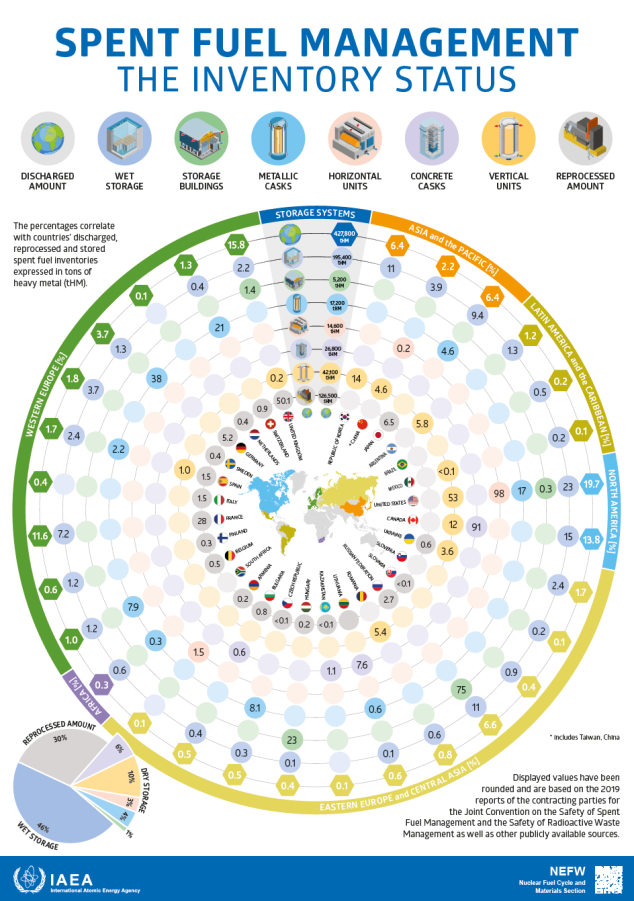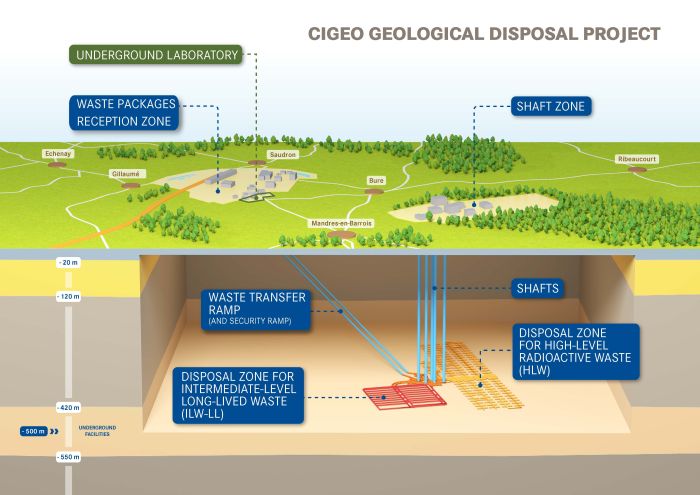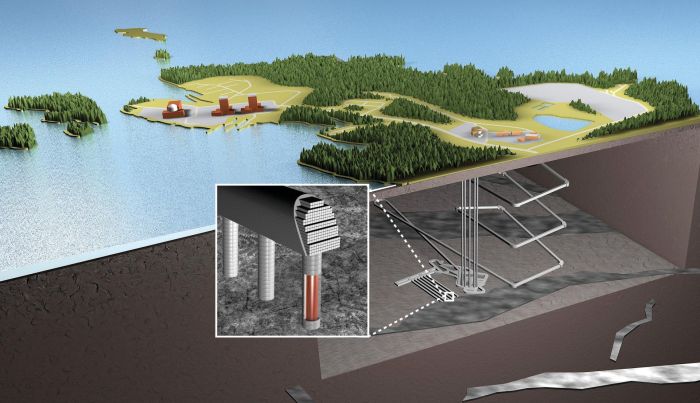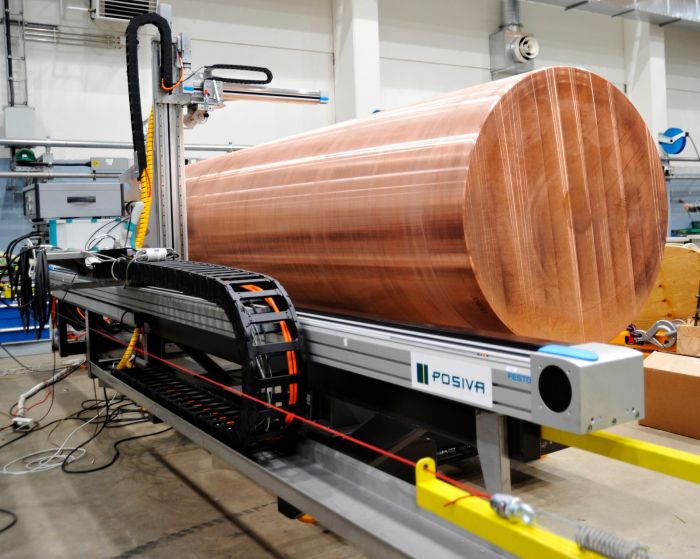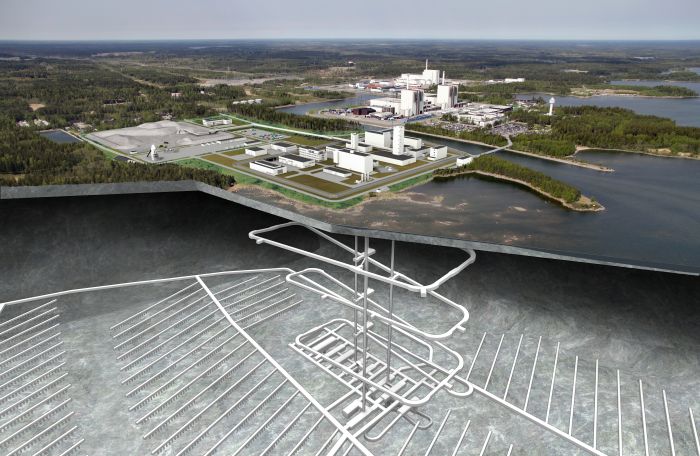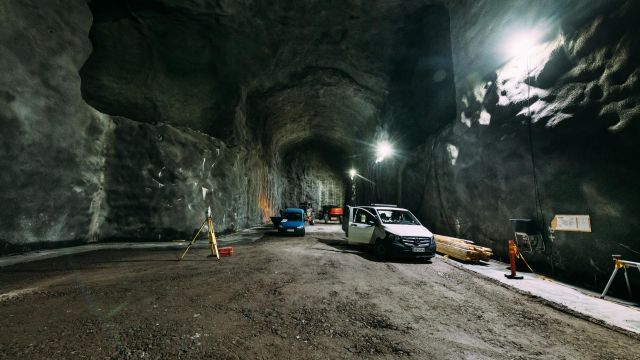
Disposal of high-level radioactive waste worldwide
According to the International Atomic Energy Agency (IAEA), more than 400,000 tonnes of heavy metal have been produced in this form worldwide (see Figure 1). However, vitrified liquid waste, for example, which is produced during the process of reprocessing fuel, must also be disposed of as highly-level radioactive waste. Until this waste can be sent to a disposal facility, it is temporarily stored in various ways (see Figure 1).
Around 30 countries worldwide operate nuclear power plants, but even in countries that do not use nuclear power, high-level radioactive waste can be produced, for example from the operation of research reactors. According to the IAEA, 70 countries operate research reactors. More than half of the 841 facilities worldwide are in the process of being or have already been dismantled.
International conventions on disposal
There is a broad international scientific consensus that the safest way to dispose of high-level radioactive waste is to emplace it in deep geological formations - not least because geological processes are easy to predict and evolve over long periods of time. The majority of countries, including Germany, France, Sweden, Finland, Switzerland, Canada and Russia, are endeavouring to build such a disposal facility. The principle here is to contain radioactive waste at the disposal site in order to isolate it from the biosphere. Most countries are aiming for an isolation period of 100,000 to one million years.
There is a whole series of international conventions and bodies that deal with the disposal of high-level radioactive waste in a broader sense. Of particular note is the Joint Convention on the Safety of Spent Fuel Management and on the Safety of Radioactive Waste Management. In it, the contracting parties - including Germany - have agreed on general safety requirements for the handling of high-level radioactive waste. At the beginning, it states quite generically:
“[…] to ensure that during all stages of spent fuel and radioactive waste management there are effective defenses against potential hazards so that individuals, society and the environment are protected from harmful effects of ionizing radiation […]”, and in relation to a disposal facility: “[…] before construction of a disposal facility, a systematic safety assessment and an environmental assessment for the period following closure shall be carried out and the results evaluated against the criteria established by the regulatory body”. Review conferences are held every three years at which the signatory countries present their progress and respond to questions from other countries. In addition, nuclear energy states have also agreed on cooperation and certain standards for dealing with high-level radioactive waste as part of the EURATOM Directive.
In addition, international organisations such as the Nuclear Energy Agency within the Organisation for Economic Co-operation and Development (OECD NEA) or the International Atomic Energy Agency (IAEO – Waste Section) promote the development of common technical standards with the establishment of corresponding expert committees.
The aforementioned conventions are general in nature and should be seen as a minimum standard for the handling of spent fuel and high-level radioactive waste. Accordingly, they should only serve as a framework for concrete country-specific regulations and the respective national legislation, as each country has its own individual requirements when it comes to disposal. For example, there may be countries that do not have the geological conditions for a deep geological disposal facility or those that have so little high-level radioactive waste that it does not make sense for them to build their own disposal facility. Longer-term storage may also initially be an option, especially for countries that want to wait and see whether new technologies or utilisation paths for the further use of the waste emerge in the coming years. The decision of the European Commission also plays a role here, according to which investments in the nuclear energy sector can, under certain conditions, be categorised as environmentally sustainable economic activities within the framework of the EU taxonomy and thus bring economic benefits.
Disposal worldwide - who is planning what?
Although there is an international consensus on the subject of disposal and extensive research is being carried out, no deep geological disposal facility is in operation as yet anywhere in the world. Finland, Sweden and, more recently, Switzerland are leading the way in this respect. In the two northern European countries, the decision on a specific site has already been made and in Finland - as a functional test for emplacement - a trial operation is currently underway with waste casks that do not contain any radioactive material. The Swiss National Co-operative for the Disposal of Radioactive Waste (Nagra) has proposed the Nördlich Lägern site. But what do other countries' disposal programmes - or rather their plans for them - look like? What technical options are being investigated and what geological conditions exist on site? What are the special features of the site selection procedures?
Here, we provide a brief overview of the current status in selected countries, supplemented by “fast facts” to allow an initial comparison. In addition to information on the host rock and the organisations involved, the ‘fast facts’ also include details on the volume of waste to be emplaced. With the exception of Germany, where the quantities of waste have already been determined as a result of the decision to discontinue nuclear power utilisation, this information should be seen as a snapshot for all other countries. In addition, the individual countries report their waste quantities in varying quality (volume, weight, with/without containers, number of containers, etc.). Unless otherwise stated, the waste volume data we provide are gross volumes including packaging. In other cases, a reference is made to the operator's website. The quantities of heavy metals are shown in Figure 1.
Further details on the waste management programmes of individual countries can be found in the respective country reports of the Joint Convention on the Safety of Spent Fuel Management and on the Safety of Radioactive Waste Management.
Germany
After decades of focusing on rock salt as a host rock and the exploration of the Gorleben salt dome, the site selection procedure in Germany was relaunched in 2013, i.a. with the establishment of the Commission on the Storage of High-Level Radioactive Waste, and placed on a new footing in 2017 with the Site Selection Act (StandAG). The act provides for the selection procedure to take place in three phases (see here). The Federal Company for Disposal (Bundesgesellschaft für Endlagerung - BGE) has been tasked with carrying out the procedure. The competent supervisory authority is the Federal Office for the Safety of Nuclear Waste Management (Bundesamt für die Sicherheit der nuklearen Entsorgung - BASE).
The StandAG stipulates, among other things, that the site must be chosen "that guarantees the best possible safety for one million years." Within this period, people and the environment are to be protected from the effects of radiation. A special feature of the law is the requirements for retrievability and possibility of recovery of the waste. For example, "[...] repository casks that have been emplaced in the repository must be retrievable by the time the repository is decommissioned." Likewise, "[...] sufficient precautions must be taken to ensure that retrieval of the emplaced repository casks is possible during decommissioning and for a period of 500 years after the planned closure of the repository."
Germany has opted for deep geological disposal for the management of its heat-generating high-level radioactive waste. The waste is to be stored in a so-called host rock which, due to its characteristics, should prevent the spread of radioactive materials or at least contain them in such a way that no risks arise for humans or the environment. In Germany, there are basically three possible host rock types for a deep geological disposal facility: salt rock, argillaceous rock and crystalline rock.
In autumn 2020, the BGE presented the Sub-areas interim report. It identifies 90 areas in Germany that have favourable geological conditions for the disposal of high-level radioactive waste and should be investigated further, as well as those that have already been ruled out at this stage, for example because mining activities have taken place there. Areas for which no or insufficient geological data is available are to be identified separately and are not excluded per se from the search process.
The current aim is to further narrow down the number of sub-areas and, in a next step, to make a proposal for siting regions that are to be explored above ground.
Amount of waste for a disposal facility: approx. 27,000 cubic metres
Possible host rock formation(s): argillaceous rock, crystalline rock, salt rock
Depth: the containment-effective rock zone is at least 300 metres and a maximum of 1,500 metres deep
Status quo and timetable: The 90 potential sub-areas are currently being summarised into siting regions (Phase I of III). A site is to be designated between 2046 and 2068.
Agencies involved (selection): Federal Company for Disposal (BGE, site search), Federal Office for the Safety of Nuclear Waste Management (BASE, licensing/supervisory authority)
Switzerland
In September 2022, the National Co-operative for the Disposal of Radioactive Waste (Nagra) proposed the Nördlich Lägern area as a site for a disposal facility in Switzerland. Like the two other sites that have most recently been shortlisted, the area has Opalinus Clay as a host rock and is located in northern Switzerland in the Zurich lowlands. According to Nagra, however, Nördlich Lägern is the site “with the greatest safety margins”. Like Germany, Switzerland has set the period under review for the deep geological disposal facility at one million years.
The next step is the general licence application, which Nagra submitted to the federal authority on 19 November 2024. This sets out i.a. the approximate location and size of the most important structures. Following a review by the Swiss Federal Nuclear Safety Inspectorate (ENSI) and the Swiss Federal Nuclear Safety Commission (KNS), it will be submitted to the Federal Council and Parliament for a decision. If they approve the application, the Swiss population can call for a referendum. Nagra predicts that the first waste can probably be emplaced in 2050.
On the German side, the Swiss Deep Geological Repository Expert Group (Expertengruppe-Schweizer-Tiefenlager - ESchT), among others, has commented on Switzerland's siting decision and considers Nagra's decision to be plausible.
Amount of waste for a disposal facility: approx. 9,300 cubic metres
Intended host rock formation: Opalinus Clay
Depth: approx. 800 metres
Status quo and timetable: The National Co-operative for the Disposal of Radioactive Waste (Nagra) has submitted a site proposal (Nördlich Lägern), for which it submitted a general licence application at the end of 2024.
Agencies involved (selection): National Co-operative for the Disposal of Radioactive Waste (NAGRA, site search, construction of a disposal facility), Swiss Federal Nuclear Safety Inspectorate (ENSI, supervisory authority).
France
France has decided to dispose of its high-level radioactive waste in a clay formation. The planned storage site is to be built in the Meuse/Haute-Marne department in eastern France and is located in the immediate vicinity of the municipality of Bure. A rock laboratory is already in operation in Bure and its infrastructure is to be used for the operation of the disposal facility. The future disposal facility, with the project name Cigéo, will accommodate both long-lived intermediate and high-level radioactive waste from all French nuclear installations and from the reprocessing of spent fuel. It is planned to construct the emplacement sites at a depth of around 500 metres. They are to be continuously expanded in the course of operation. Separate storage areas are planned for high-level and intermediate-level radioactive waste (see illustration, red and yellow areas). Once the waste has been emplaced - for which a period of more than 100 years is planned - the repository is to be sealed.
The National Agency for Radioactive Waste Management (Andra), which reports to the Ministry of the Environment, is responsible for the planning and construction of the repository and the above-ground packaging facilities. In 2023, the application for a construction licence was submitted to the Ministry of Energy Transition and is currently being reviewed by the Autorité de sûreté nucléaire et de radioprotection (ASNR). Emplacement is scheduled to start in 2030.
Cigéo design: 10,000 cubic metres of high-level radioactive waste and 73,000 cubic metres of long-lived intermediate-level radioactive waste
Intended host rock formation: argillaceous rock
Depth: approx. 500 metres
Status quo and timetable: At the beginning of 2023, Andra submitted an application for planning permission for the Cigéo site to the Ministry of Energy. In addition to the technical review by ASNR, for example, public involvement and finally the government's decision will follow. This is expected to take up to five years.
Agencies involved (selection): National Agency for Radioactive Waste Management (Andra, site search), Ministry of Energy Transition (supervision)
Finland
The world's first repository for high-level radioactive waste in crystalline rock is currently being built in Finland (Onkalo). The site is located on the island of Olkiluoto in the municipality of Eurajoki on the west coast of Finland and is only a few kilometres away from the Olkiluoto nuclear power plant. At the end of 2021, the operator Posiva Oy (a joint venture between the operating companies of Olkiluoto and Loviisa) submitted an application for an operating licence to the Ministry of Economic Affairs and Labour.
The “trial run of final disposal”, in which the entire disposal process is tested with simulated fuel assemblies, has begun. The first spent fuel is to be emplaced in 2025.
Amount of high-level radioactive waste to be emplaced in Onkalo: 6,500 tonnes or 3,250 containers (cf. Posiva report). This corresponds to a volume of around 13,600 cubic metres. This is only part of the high-level radioactive waste accrued in Finland.
Intended host rock formation: crystalline rock
Depth: approx. 400 - 455 metres
Status quo and timetable: The operator began a functional test for emplacement in 2024 and the Onkalo disposal facility is scheduled to start operating in 2025.
Agencies involved (selection): Posiva Oy (waste management company), Säteilyturvakeskus (STUK, supervisory authority).
Sweden
The disposal facility for spent fuel assemblies is to be built in Söderviken near the Forsmark nuclear power plant in granite rock at a depth of around 500 metres. In a search process lasting decades, all municipalities in Sweden had previously been contacted. In Östhammar, the geological conditions and the consent of the local population finally came together. In 2022, the Swedish parliament authorised the construction of the disposal facility.
The Swedish Nuclear Fuel and Waste Management Company (SKB), which is owned by the companies operating the nuclear power plants, is responsible for site selection and construction of the disposal facility. SKB anticipates a construction period of 10 years from the start of construction.
Quantity of high-level radioactive waste: 6,000 containers with approx. 25,000 cubic metres
Intended host rock formation: crystalline rock
Depth: approx. 500 metres
Status quo and timetable: SKB plans to start construction work on the proposed Forsmark disposal facility site in the 2020s and emplacement ten years later. Government approval is currently still pending.
Agencies involved (selection): Swedish Nuclear Fuel and Waste Management Company (SKB, operator), Swedish Radiation Safety Authority (SSM, supervisory authority)
USA
In 1987, following a selection process involving eight other possible sites, the US government designated Yucca Mountain as the location for a disposal facility for spent fuel and other high-level radioactive waste in the Nuclear Waste Policy Act. The mountain ridge, which is located around 130 kilometres north-west of the Las Vegas Valley in the state of Nevada, is already home to an experimental laboratory of the same name in the tuff rock. The original plans for a disposal facility envisaged a tunnel complex around 300 metres below the top of Yucca Mountain with a capacity of around 70,000 tonnes of radioactive waste. The legal requirements for the construction and operation of a disposal facility are published in the Code of Federal Regulations (CFR), among others.
Licensing work for the originally planned repository in the Yucca Mountains is currently not being pursued. Spent fuel is currently being stored on site by the operators until a site for a disposal facility has been determined.
Amount of high-level radioactive waste (only used fuel assemblies): 90,000 tonnes (cf. information provided by the U.S. Government Accountability Office)
Intended host rock formation: Volcanic tuff rock (Yucca Mountain)
Depth: approx. 300 metres (Yucca Mountain)
Status quo and timetable: The site selection process is currently suspended and no timetables are available from the authorities.
Agencies involved (selection): Department of Energy (DOE, supervisory/licensing authority), Nuclear Regulatory Commission (NRC, research into the suitability of Yucca Mountain)
Russia
Russia does not yet have a disposal facility for high-level radioactive waste but is currently building an underground research laboratory in the gneiss of the Nizhnekansk massif in Zheleznogorsk in the Krasnoyarsk region (Siberia). Completion is scheduled for 2025, after which the underground laboratory is to be operated until 2030. If the site proves to be suitable, emplacement of both high-level radioactive waste and low- and intermediate-level radioactive waste at a depth of 450 - 525 metres could begin from around 2035.
The work is part of the national strategy to create a standardised state system for the disposal of radioactive waste. Due to its diverse and long-standing activities in various areas of nuclear technology (including the reprocessing industry, nuclear submarines, etc.) and its size and the associated energy requirements, Russia has accumulated considerable quantities of radioactive waste.
The National Operator for Waste Management FSUE (NO RAO), a subsidiary of the state corporation Rosatom, is responsible for the planning and implementation of a disposal facility site for high-level radioactive waste.
Amount of high-level radioactive waste to be stored: 20,000 tonnes in the first (of several) construction phases (cf. World Nuclear Association)
Intended host rock formation: gneiss
Depth: approx. 450 - 525 metres
Status quo and timetable: The decision on the construction of the disposal facility should be made by 2025 and the facility completed by 2035.
Agencies involved (selection): Rosatom (federal authority) and its subsidiary FSUE NO RAO (planning and operation of waste storage facilities)
Other countries at a glance
The Netherlands is planning to store its radioactive waste above ground for a period of at least 100 years. During this period, research will be carried out into possibilities for the (reversible) deep geological disposal of radioactive waste. Initial investigations have shown that the geological disposal of radioactive waste in suitable rock formations, which can be found deep underground in the Netherlands (salt and clay formations), is feasible in principle. In addition, the country is also interested in a multinational approach to disposal, in which several countries join forces for a disposal facility.
Spain does not yet have a site for a disposal facility for high-level radioactive waste. Plans for a centralised storage facility were halted in 2018, meaning that the waste is currently stored at the nuclear power plant sites. ENRESA is the agency tasked with finding a disposal facility. It conducts research into both geological disposal (options: crystalline and sedimentary rock as well as salt rock) and the transmutation process. However, no concrete steps are currently being taken to search for a site.
In Belgium, no decision has yet been taken on the location of a disposal facility. Research is being carried out into the deep geological disposal of medium and high-level long-lived radioactive waste. The Boom Clay near the city of Mol is being investigated as a possible host rock. Construction work for the underground research laboratory "High-activity disposal experimental site (Hades)" began there in 1980. Hades is operated by the cooperation ‘European underground research infrastructure for disposal of radioactive waste in a clay environment’ (Euridice), which was founded by the Belgian Organisation for the Storage and Disposal of Radioactive Waste (ONDRAF/NIRAS) and the Belgian nuclear research centre SCK.CEN.
Správa úložišť radioaktivních odpadů (SÚRAO) has been entrusted with the search for a deep geological disposal facility for high-level radioactive waste in the Czech Republic. In 2020, following surface exploration of seven potential sites, the government narrowed down the possible locations to four sites in crystalline rock: Hrádek and Horka in the central region of the country, Březový potok in the south-west, and Janoch near the Temelín nuclear power plant. The authorities believe that all of these sites fulfil the safety requirements for a deep geological disposal facility and are now being investigated in more detail. In addition, a research and development programme is underway to establish exploration methods, emplacement techniques and construction workflows. The work is being carried out in three underground laboratories, including Bedrichov, Josef and Bukov. Construction of a disposal facility is scheduled to begin in 2050, with commissioning planned for 2065.
As a subsidiary of the British UK Nuclear Decommissioning Authority (NDA), Nuclear Waste Services (NWS) is tasked with finding the plans for a deep geological disposal facility for high-level and intermediate-level waste - such as that stored temporarily on the site of the nuclear complex in Sellafield. The operation of a disposal facility is planned from around 2040 and a site is expected to be selected in 2025. As part of the selection process, municipalities with fundamentally suitable geological conditions (clay, crystalline and salt) were able to voluntarily apply as a site for a disposal facility; three municipalities did so. In January 2019, the government initiated the official site selection procedure. In October 2021, two sites in Copeland began the second phase of the review process.
The Canadian Nuclear Waste Management Organisation (NWMO) has been entrusted with the search for a disposal facility site. Two areas in the state of Ontario are currently still at an advanced stage of the selection process: the Wabigoon Lake Ojibway Nation-Ignace area (crystalline rock) in the north-west and the Saugeen Ojibway Nation-South Bruce area (sedimentary rock) in the south. The municipalities applied as part of a nationwide selection process.
In Japan, the Nuclear Waste Management Organisation (NUMO) is involved in the search for a geological repository for highly-level radioactive waste. As the islands belonging to Japan are located in a tectonically active area, there are special challenges for disposal. Not only must areas not be located in the vicinity of volcanoes or active faults, but this aspect must also be taken into account in a specific disposal concept. Municipalities were initially able to voluntarily apply for the selection process - but without the hoped-for response - so the Ministry of Economy, Trade and Industry (METI) initiated further investigations into two potential sites in 2020. These are seismically quiet areas in the municipalities of Suttu and Kamoenai, which are located south and north of the Tomari nuclear power plant on the west coast of the island of Hokkaido. The areas were selected on the basis of a literature study on geological boundary conditions.
The Horonobe (clay rock) and Mizunami (crystalline rock) underground laboratories are also operated in Japan.
State: April 2025
